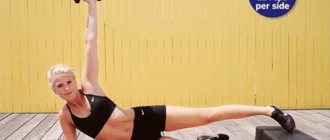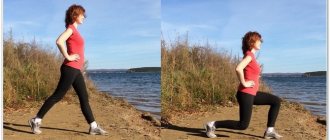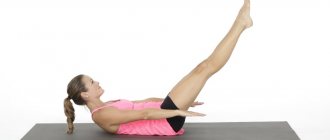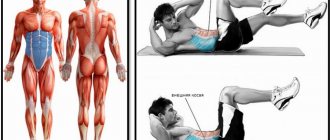Leg raises are an abdominal exercise. It partially engages the front of the thigh. The movement itself came to us from gymnastics. There, this exercise is performed in full support - hands hold the handles, elbows are straightened and inserted, and the legs are fully raised with the toes above the midline, passing at waist level. In the fitness version, the movement is performed in a machine, with the athlete standing on his forearms.
Execution technique
- Initial position
- Stand facing the machine;
- Step onto the footrests;
- Grasp the handles with your hands;
- Turn your back to the stops;
- Take a standing position on your forearms.
Movement
- The exercise itself is simple:
- You need to shorten your abs and pull your stomach inward;
- Next, the straight legs are brought upward by contracting the abs and pulling the pelvic bones to the lower ribs;
- For maximum contraction, the hips must pass the midline of the abs;
- Once peak contraction is achieved, the legs should be released slowly and in a controlled manner.
It's the HANGING LEG RAISES, baby.
Attention
- It is necessary to completely eliminate attempts to cheat with your feet. The technique used in competitive CrossFit for the toes to bar exercise is not valid or acceptable here;
- The knees do not need to be pushed in tightly so that the legs are straight. With this position of the joint, it will not be possible to achieve a full contraction of the abs, and the legs will be partially driven by the quadriceps;
- The tension in the trapezoid needs to be removed. Shoulders raised to the ears are a bad help here. They will only contribute to an even greater buildup of the body and an active violation of technique, in addition, shoulders to ears greatly increase the risk of spasm of the trapezius itself and pain after training;
- Throwing your legs down is not recommended. For beginners, a barbell is often placed on the midline across the lower clamps of the machine so that they do not lower their legs below this bar and work in a balanced manner.
Important
- The legs need to be lifted using the press, and not by the force of swing, inertia and quadriceps. To achieve this, you need to imagine how the pelvic bones are drawn to the lower ribs, and not how the athlete actively throws his legs;
- After passing the midline with your hips, you need to bring your legs a little higher, and then not throw them down, but smoothly “unwind” your abs and lower yourself down;
- You can’t pull your socks back like a ballerina, then they will allow you to “insert” your knees as much as possible, and the quadriceps will engage in work, but on the contrary, you need to work with your abs;
- You can master this movement better if you learn how to do a pelvic lift while lying down with your legs straight and pulled up. You need to understand exactly how the rectus abdominis muscle contracts, and not how a person simply swings his legs above the waist.
Preparing the body for parallel bars
Anyone who has been to the gym or visited sports grounds has seen how muscular guys perform various exercises on the horizontal bars and uneven bars. From the outside, all these movements seem easy and simple.
Not everyone has tried to repeat this themselves. It's always easier to see than to do. Just try standing on the uneven bars with straight arms for a while (starting position). And this is the first difficulty - your hands may not be ready to hold your body in this position. Simply put, your arms will buckle, your palms will hurt, and you may slip off the bars and fall.
The initial position on the uneven bars for almost any exercise is to stand on straight arms. At this time, the body hangs in the air, and there is no support under the feet.
For a person weighing up to 65–75 kg, this is not as difficult as for heavier people. Imagine whether the owner of a beer belly, whose weight is over 90 kg, and whose arms are not prepared for physical activity, will be able to get into the starting position. If you are heavy enough, you can see for yourself.
Before you try to pump your abs using parallel bars, do push-ups from the floor at different angles, strengthen your arms and prepare your joints. We do not recommend that unprepared people go straight to the projectile.
However, if you are very brave and purposeful and decided, despite our warnings, to hang on the uneven bars and pump up your abs there, the following recommendations are for you:
- Stand in the starting position (on the uneven bars with straight arms), press your elbows to your chest. Before you pump up anything, you need to know how long you can hang like that. You need to hold out for 10 seconds. If this is your limit, gradually increase it to 60 seconds.
- Try doing push-ups - first bend your arms slightly. If this is your limit, over time you will need to learn how to do push-ups. If you can already do full range of push-ups at least a couple of times, good. At this stage, you can start doing exercises.
Now let's find out how to pump up the press using parallel bars.
Execution options
Raising the knees while resting on the elbows
This version of the exercise is suitable for beginners and those who find it difficult to lift their straight legs up. It is anatomically simpler, as it is easier to understand how to bring the hips to the ribs if the legs are bent. The athlete takes the starting position similar to the previous option, and then carefully pulls the pelvic bones to the lower ribs. Lowering is also smooth. There is no need to straighten your knees with each repetition.
Side leg raises
This is the same gymnastic exercise that imitates a fitness option. For fitness purposes, you do not need to learn to throw your legs with your toes pointed up due to inertia and rotation in the shoulder joints. Here you need to carefully pull up your straightened legs with your toes pulled slightly above the midline of the body, and just as carefully lower the entire “structure” back.
Leg raises supported by parallel bars
This option is intended for those who want to pump up their oblique muscles. Here you need to pull your knees to your waist, but “obliquely”, aiming your knees first to one or the other shoulder.
Leg raises: 3 difficulty options
Analysis of the exercise
Anatomy of exercise - which muscles work
This exercise uses the rectus abdominis muscle as the main engine. If an athlete bends his knees, then the hip flexors are also involved; if done carelessly, the load often goes into the quadriceps. The back muscles work as stabilizers and are activated when the athlete brings his shoulder blades together and lowers them towards the pelvis.
pros
- This movement allows you to build a strong core, especially for those who have problems pumping the rectus abdominis muscle due to significant lumbar lordosis;
- The exercise uses the abs in isolation, but provides a significant load;
- One of the movements that relieves tension from the iliacus muscle. Those who like to work their back and buttocks with hyperextensions and any kind of bending with a barbell need to do one of the hanging leg raises. This option is suitable even for those who have already done a fair amount of work on their grip and have done a bunch of deadlifts;
- The exercise is well suited for those who have problems with fixing the upper back and hanging coverage. It allows you to relieve the compression load from the spine, but does not additionally involve the muscles of the forearm and palm. Thus, the movement allows those who perform a lot of deadlifts to get their share of the load;
- This exercise will help relieve tension in your lower back. The athlete must press his back well against the back of the machine and work by twisting upward.
Disadvantages of the exercise
- The movement will be technically difficult for those athletes who have not learned to work with the press and are trying to throw their legs by inertia, or lift them by swinging and using the body. Such athletes may not be able to perform the exercise correctly the first time;
- Spasms of the trapezius muscle with weak or, conversely, overloaded trapezius is a typical disadvantage of this movement.
Advantages and disadvantages of standing leg raises
Let's start with the advantages:
- Uniform load on muscles. The parallel bars, or rather the vertical position of the body, allows you to work the rectus abdominis muscle, involving in the work the lower part of the rectus muscle, which is least involved in straight crunches on the floor.
- Burns more calories. Compared to exercises on the floor, lifting on parallel bars is a more energy-consuming exercise, as it requires additional fixation of the body in the simulator, due to which the muscles of the shoulder girdle are involved in the static load.
- The presence of a support allows you to eliminate body swaying, for example, as when hanging on a bar, which makes the exercise technique clearer and more concentrated.
Disadvantages of the exercise:
- Quite a difficult exercise that requires good position stabilization . When the elbows and lower back are supported, the load on the shoulder girdle is not reduced. If the shoulder and chest muscles are untrained, there is a high probability that the neck will sag under the shoulders, which will additionally overload the trapezius muscle and the sternocleidomastoid muscle of the neck, which will also make breathing difficult.
- Weak abdominal muscles will also not cope with the load , despite the fact that the exercise is intended to strengthen them. In addition to dynamic lifts, the abdominal muscles are also responsible for stabilizing the body in the machine, controlling the fit of the lower back to the back of the machine and are in constant tension, which cannot be interrupted during the approach. Let's return to this point in technology. Therefore, you should start doing leg raises on the uneven bars only after mastering the option lying on the floor.
Preparing for the exercise
Preparation can be considered normal and joint warm-up, as well as warm-up of the hip joint. But in ordinary life, this movement is performed as the last exercise of the workout, therefore the entire workout serves as a kind of warm-up; there is no need to perform additional warm-ups. Sometimes it is recommended to do one set of pelvic lifts from a supine position before lifting your legs in a hanging position in order to engage the abs in the work.
Lying leg raise technique, variations, important points
Exercises
The most common problem on the way to an attractive flat stomach is the fat layer in the lower abdomen. It can spoil the appearance even of avid athletes who have visible abs in the upper sections. But it’s a little more difficult to work on the lower abdomen. An exercise with leg raises while lying on your back is ideal for pumping the lower abdomen. How to do it correctly - read below.
Lifting your legs while lying down can be done simply on the floor on a mat, on an inclined bench. This exercise is well suited for beginner athletes because it is a lighter version of hanging leg raises. Since it does not require a special tool, it can be done at any time and in any circumstances. The abdominal muscles work by lifting their own weight.
What does the exercise do?
The lying leg raise exercise is aimed at:
- strengthening the abdominal muscles;
- increasing endurance and strength load of the abdominal press;
- prevention of osteochondrosis and intervertebral hernias;
- increasing the overall tone of the body as a morning exercise.
Depending on the physical activity, the exercise can be performed in different variations. For example, it will be easier for beginners to do alternating leg raises while lying on the mat.
Execution Variations
The starting position is this. The back is pressed tightly to the floor, there is no deflection in the lower back. Hands lie along the body.
First, we raise one leg to a level of 45-60 degrees, fix the position a little and lower the leg. As soon as the first leg touches the floor, the second one rises to the specified level. We exhale while lifting, inhale while lowering the limbs. You can start with 2 sets of 10 times on each leg.
An exercise of medium difficulty looks like this. The starting position is the same, legs together. Raise both legs to 45-60 degrees, hold in this position for 1-2 seconds and lower.
To complicate such lifts, you can not lower your heels to the floor, but keep your legs slightly suspended. Then the abs will be tense all the time throughout the entire exercise. We perform 2-3 sets of 10-15 repetitions, over time increasing the number of repetitions to 30 on each leg.
A more complicated version of leg lifts in a lying position is performed with weights. But if you are just starting to play sports, do not immediately resort to complex variations of the exercise.
Increase the difficulty gradually as your abs develop. The exercise technique remains the same, but a weight is attached to each leg. Its weight varies according to your desire and health status.
Helpful advice: remember that when you raise your legs above 60 degrees or below 45, the load on the abs is lost.
What are the errors?
The following mistakes are often encountered when performing lying leg raises:
- separation of the body following the limbs;
- classes on a cold floor without a mat;
- lifting legs with jerks;
- no fixation in the raised position of the legs;
- sudden throwing of legs down;
- do not exercise on a full stomach; wait at least one hour after eating.
You can watch how to perform lying leg raises in the video below.
This is interesting: Traction of the upper block - we describe it point by point
Proper execution
- Your back must be firmly pressed against the back of the machine and during the exercise, do not tear it off;
- The shoulder blades must be brought together to the spine and lowered to the pelvis, and the abs must be tightened, only then will it be possible to pull the lower ribs to the pelvic bones;
- Swinging of the legs is not allowed, there is no need to bring them behind the line of the back after lowering, and “throw them off” from top to bottom with sudden movements;
- The exercise is performed according to the general rules of synergy between muscle contraction and breathing, that is, exhalation occurs with effort;
- The movement should not be too active, that is, fast. You need to try to work more smoothly, and avoid sudden jerks and throwing your legs
Doing the exercise on your back
- Beginners should start by lifting each leg alternately, as lifting both legs at once can cause displacement of the intervertebral discs.
- To begin, lie down on the mat so that your head, lower back, pelvis and legs lie flat. We straighten our arms completely parallel to the body.
- Then we begin to lift any of the legs without lifting other parts of the body from the floor. The leg lift should be forty-five to sixty degrees.
- When the heel of one of your feet touches the floor, you can begin to lift the other leg.
- To begin with, you need to perform two or three approaches, ten to twelve repetitions for each.
- Also don't forget about breathing. Exhalation must occur at maximum load.
Errors
- You cannot swing your legs sharply, change the position of your forearms on the supports and push your toes towards the bar too quickly;
- It is better to do the exercise synchronously with breathing, and not change the position of the body at random and hold your breath while making an effort;
- You should not place your hips behind the line of your back, so as not to gain excess inertia and train efficiently.
Raising the legs while resting on the elbows
Useful tips
The first and most important tip: do not perform the exercise with straight legs . At this moment, the press stops working and the entire load goes to the lower back. This may cause injury. Legs must be bent at the knees. When reaching the top point of the amplitude, it is worth twisting your pelvis slightly upward. It is at this moment that the abdominal press is maximally tense.
Beginners need to remember - the more your legs are bent, the easier it is to lift. This should be taken into account during your first training sessions. For those people who suffer from excess weight, experts generally do not advise exercising on such a simulator.
Usually in such cases the shoulders cannot support the weight of the body, so it is better to pump up the abs using simpler exercises. You can return to doing push-ups on your elbows after a few months, when some of the excess weight is gone and your shoulders are stronger.
Fish oil: benefits and harm. We tell the whole truth about this product!
Are you interested in fractional meals for weight loss? At /nutrition/menu/drobnoe-pitanie-dlya-pohudeniya.html you will find a good article.
For those athletes who easily lift their own weight, you can make the work more difficult using a dumbbell held between your feet. You can also place a barbell disc on your feet. Thus, the exercise becomes so difficult that it must be done slowly so that the weight does not fly down. At the same time, you can not lower your legs too low - this will allow you to maximally strain the lower abdominals.
Tips for increasing the effectiveness of the exercise
- Experienced athletes can do this exercise with weights. It is convenient to hold the medicine ball between your shins and lift your legs up. If there is no ball in the gym, you can try hanging weights on your feet, or lifting a dumbbell by holding it between your legs. At a slow pace of exercise, this is more than realistic;
- The start always occurs through the muscles of the legs, but if you move your hips forward a little and start by twisting your abdominal muscles, you can make the exercise more effective;
- The slower the pace, the better it will be to pump up your abdominal muscles;
- If you use the option for pumping obliques, it is important to press the upper back to the back. The hips must be carefully brought to one and the other shoulder;
- It is more effective to do the exercise with straight legs, but in this case you need to maintain a slight angle in the knee joint and not straighten your knees completely;
- Bent legs are suitable for beginners and those who find it difficult to do twisting.
Raising bent legs in support on parallel bars
Despite the fact that this is a simpler option, since the load on the rectus abdominis muscle is reduced by bending the legs, it also has its own technical nuances and features.
- The starting position is completely repeated.
- Straight legs below are together.
- Next, exhale, lift your legs up, bending your knees to a right angle, bring them to your chest, but do not tear your lower back from the back.
- That is, in the upper position of the knees, the back remains completely pressed against the machine, despite the design of the machine - vertical or inclined.
- As you inhale, slowly lower your knees, gradually straightening them, but, be careful , do not fully straighten them at the lowest point, maintaining tension in your abdominal muscles and the position of your lower back. Thus, the legs should not be strictly vertical with the body.
Inclusion in the program
It is worth including this movement in the training program at the stage when you already have the physical ability to perform the exercise and there are no problems with mobility in the hip joints. Beginner women often simply cannot hold onto the forearm stand. They fall down due to the fact that a weak back and trapezius do not allow them to stabilize their own weight. Girls should first strengthen their backs with pull-downs and standing (plank) exercises, and then do this movement. You can replace the exercise with hanging leg raises.
Typically, the movement is included on the day when the athlete squats rather than pulls, but with the parallel bars this rule does not work; you can do any option, even if it is not possible to space the deadlift and abdominal exercise on different days.
Options for pumping up the press on uneven bars
Below are the most popular and effective exercises with which you can work your abdominal muscles using the equipment we have chosen.
Walk on the uneven bars
Starting position – stand on the uneven bars with straight arms. We lean forward a little, lower our head a little:
- Raise one knee slightly higher than the bars.
- At the moment when it is halfway back, we begin to raise the second knee.
- It turns out that we are imitating a step with a high knee lift on the uneven bars.
We do this exercise 10–15 times on each leg. This is the best option for those who do not yet have strong abs, but who can already do something on the uneven bars.
Leg raises on parallel bars
This is a classic abdominal exercise. You can do it in several ways:
- on straight arms;
- place your elbows on the bars.
The second option may leave bruises on the elbows. It is better to perform it on special soft bars in the gym. The grip of the parallel bars is not the same as with push-ups. Be careful not to let your hands slip.
Let's consider the technique of the first type of exercise:
- We get up to the starting position with straight arms. We tilt our head and chest slightly forward to avoid rocking.
- Raise your legs just above the level of the parallel bars or all the way to your chest. If you raise your legs just above parallel, the lower abs work mainly. As you pull your knees toward your chest, your pelvis will begin to follow your legs. In this case, the load will be distributed to the upper part of the press. For convenience, we recommend raising your knees together with your pelvis up to your chest or chin.
- We do 10–15 repetitions in three approaches (or two, if there are also exercises for the abdominal muscles).
If you lift your legs straight or slightly bent, your center of gravity will shift and your body will begin to sway. It is not comfortable. But you can try doing straight leg raises as well.
When it becomes easy for you to do this type of exercise, attach weights to your legs. Work with them to tone your abdominal muscles even more. It only makes sense to accelerate to 30, 50 or more repetitions when you need enormous endurance (for acrobats, climbers, etc.). In cases where you want to pump up abs, 10–15 repetitions per set are sufficient.
When you perform this type of exercise with your elbows on the bars, you dramatically reduce the risk of your body rocking back and forth. On the one hand, it’s more convenient to pump up your abs this way, on the other hand, it can be painful for your hands.
Acrobatics for the press on uneven bars
Leg raises can be performed more effectively if:
- At the moment when your legs are above the bars, spread them apart. You can do this several times.
- You can straighten up parallel to the ground while remaining face up. At the same time, you will stand with your elbows on the uneven bars.
roman chair
The beams are 2 pipes located next to each other. This means they can be used as a Roman chair. Here you can pump both your back and your upper abs. Exactly what we need:
- We sit on one of the pipes. We fasten the legs to the second one. Usually the emphasis is on the shins. It is advisable to secure the ankle. It’s very good if you have a high sneaker: all the pressure of the pipe will go only to it, and not to your foot.
- We put our hands behind our heads or clasp them in a lock on our chest.
- Please note that the first tube you sat on should be located just below your buttocks. This is necessary so that you do not fold between the bars and fall down.
- We bend down until it is parallel with the ground. There is no point in going lower - we are not pulling the abs, but pumping them up. For beginners, it is advisable to round your back if you cannot perform the exercise with a straight back without pain. The main thing is not to bend in the lower back.
- We do 2-3 sets of 15 times.
By the way, if your back hurts, you should first strengthen your abs with easier exercises. Don't forget about hyperextension for the back muscles.
Contraindications
- Intervertebral hernias and protrusions are considered a contraindication for this exercise, but this is not recognized by all trainers. A number of experts believe that you can perform exercises in this style without any problems, even if there is a hernia, but then you will have to twist quite smoothly and train slowly, under control;
- Diastasis of the rectus abdominis muscle is a contraindication for all crunches, including this exercise too;
- The movement is not suitable for training pregnant women, although it does not involve direct pressure on the abdominal area;
- This option cannot be performed with injuries to the hip joints;
- If a person cannot move his head away from his shoulders and stand firmly throughout the entire approach, he should strengthen the trapezius muscles;
- You should not do the exercise when the trapezius is overtrained and the inflammatory process has already begun;
- Usually the movement is not placed on a heavy bench day if the lifter prefers a medium grip and triceps press;
- The exercise is contraindicated for radicular syndrome, that is, pinched nerves in the lumbar spine;
- Forearm stand is not recommended for injuries and inflammation of the elbows, shoulders, and other joints. It should not be done for cervical osteochondrosis if pinched nerves occur.
Interesting fact
This is a favorite exercise of past champion Mike Francois. He believed that only hanging leg raises help build a strong and sculpted abs, and no twisting can compare with lifting in this great matter. Mike recommended alternating regular hanging leg raises with weights, and a fast tempo with a slow tempo to get better abs. He did the movement three sets to failure, but fitness enthusiasts can limit themselves to 3 sets of 12-15 repetitions. Only experienced athletes should do more.











